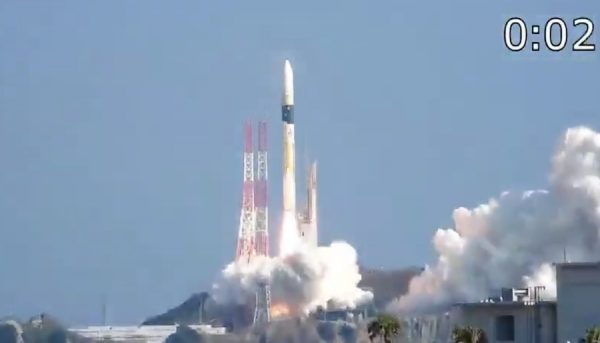Japan launches optical spy satellite – Spaceflight Now
EDITOR’S NOTE: Updated after launch.

Japan launched an optical reconnaissance satellite from the Tanegashima Space Center Sunday aboard an H-2A rocket after a 12-day delay caused by a nitrogen leak.
Japanese crews returned the H-2A rocket to its vertical assembly building at Tanegashima for repairs following the aborted countdown Jan. 27. Officials from Mitsubishi Heavy Industries, builder and prime contractor for the H-2A rocket, said the leak detected during the previous countdown was in the system providing conditioned air to the rocket.
The 174-foot-tall (53-meter) H-2A rocket returned to Launch Pad No. 1 at the Yoshinobu launch complex at Tanegashima Saturday in preparation for the mission’s second launch attempt.
MHI teams gave approval to load super-cold liquid hydrogen and liquid oxygen propellants into the two-stage H-2A rocket in the hours before liftoff.
MHI and the Japan Aerospace Exploration Agency, which owns the Tanegashima Space Center, did provide a live webcast of Sunday’s mission. Japanese launch officials typically provide live video coverage of space launches, but not for missions carrying the country’s spy satellites.
News media and spectators gathered around Tanegashima streamed live video of the launch from nearby viewing sites.
After beginning an automated terminal countdown sequence, the H-2A switched to internal power and pressurized its cryogenic propellant tanks before igniting its first stage LE-7A main engine at T-minus 5.2 seconds.
The engine throttled up and passed a computer-controlled health check before the H-2A ignited two strap-on solid rocket boosters to climb away from Tanegashima Island in southern Japan at 0134 GMT Sunday (8:34 p.m. EST Saturday).
Liftoff occurred at 10:34 a.m. Japan Standard Time on Sunday.
The H-2A rocket soared into clear skies and headed toward the south from Tanegahima with 1.4 million pounds of thrust from its first stage engine and strap-on boosters. The solid-fueled rocket motors burned out and jettison nearly two minutes into the flight, and the H-2A’s aerodynamic payload shroud separated roughly four minutes after liftoff.
Shutdown of the LE-7A first stage engine and stage separation occurred nearly seven minutes into the mission, and the upper stage’s LE-5B engine fired to place the Japanese government’s newest spy satellite into polar orbit.
Officials confirmed separation of the intelligence-gathering payload around 21 minutes after liftoff.
Japan’s government-owned orbiting robotic spy platforms are officially known as “Information Gathering Satellites” and come in radar and optical imaging variants. The spacecraft awaiting liftoff on the next H-2A flight — designated IGS Optical 7 — is the 18th Information Gathering Satellite launched by Japan’s government since 2003, including two satellites lost in an H-2A launch failure.
The spacecraft’s specifications, including its imaging performance, are kept secret by the Japanese government. The Information Gathering Satellites are operated by the Cabinet Satellite Intelligence Center, which reports directly to the Japanese government’s executive leadership.
The H-2A rocket with the IGS Optical 7 satellite flew in the basic “202” configuration with two strap-on solid rocket boosters. Heavier satellites launching on the H-2A sometimes need four boosters to reach orbit.
The mission marked the 41st flight of an H-2A rocket since 2001, and the first Japanese space launch of 2020.
Email the author.
Follow Stephen Clark on Twitter: @StephenClark1.






